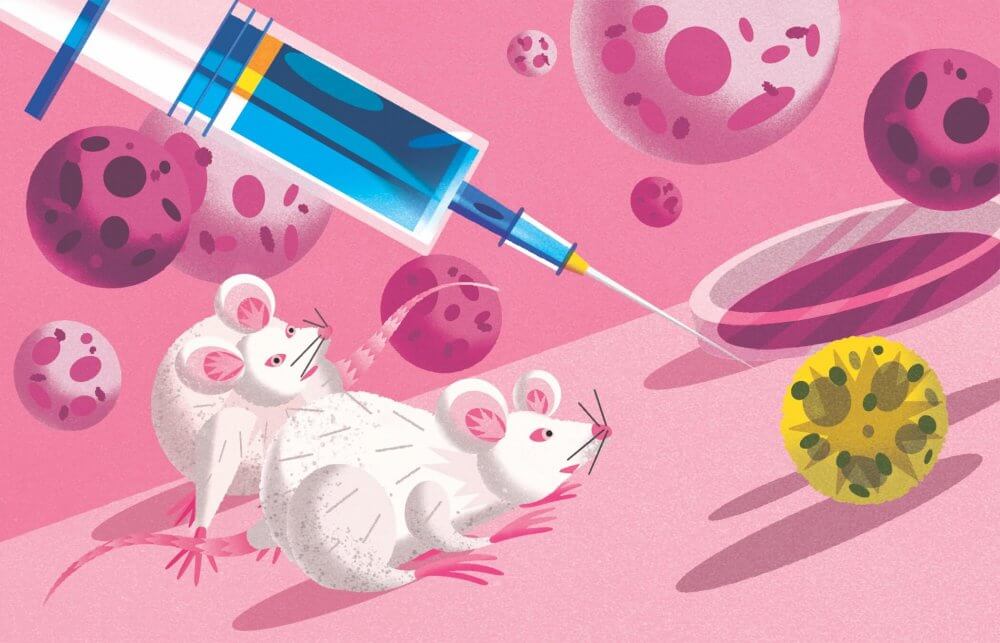A menagerie of genetically engineered mice, rats, macaque monkeys, rats, ferrets, hamsters, dogs and even horses have been enlisted in the race to find drugs and vaccines to thwart severe acute respiratory syndrome coronavirus 2 (SARS-CoV-2), the infectious agent responsible for the COVID-19 pandemic. Grim statistics lend urgency to this marathon, with the World Health Organization reporting more than one million global deaths and well over 30 million confirmed cases at deadline. Governments, trying to calm a frustrated and frightened populace, speak optimistically about pending new treatments as well as the ultimate goal, a vaccine.
But some scientists and medical professionals are crying foul. The animals that are being used as laboratory test subjects in the search for COVID-19 therapeutics might be hindering, rather than helping, the race, they say. The virulence and highly contagious nature of COVID-19 is demanding a new model of research that bypasses animals, instead using human-biology-based testing. A growing number of scientists suggest that accelerated COVID-19 research is exposing animal modelling for what many have long claimed it to be: a scientific anachronism.
Dr. Thomas Hartung is the director of the Center for Alternatives to Animal Testing (CAAT), a laboratory for developmental neurotoxicity research based on genomics and metabolomics at Johns Hopkins University. Hartung points to the slow trajectory of drug and vaccine development using animal modelling. Conventional drug development relies heavily on animal testing to understand the molecular mechanisms of disease and potential treatments, helping to explain why it takes more than 10 years to get a medication to market, while vaccines typically take 12 years, says Hartung. Such lengthy timelines translate into a hefty medical bill: roughly $2 billion per drug. With COVID-19, “we cannot wait that long for treatments,” says Hartung, who spoke to online delegates at the 11th World Congress on Alternatives and Animal Use in the Life Sciences in August. “We have to be faster than we were in the past.”
Equally problematic, if not even more eyebrow raising: 95% of new drugs that enter clinical trials don’t make it to the market, according to the National Center for Advancing Translational Sciences, at the U.S. National Institutes of Health (NIH). In other words, the vast majority of new drugs fail once they move into human studies, despite appearing safe and effective in experiments with animals.
In science, as in other areas, necessity is the mother of invention. The rapid acceleration of innovations like three-dimensional human organs on a microchip are being refined. These living organoids are accelerating the development of effective medical advancements for the many virulent maladies afflicting humans, including, most urgently of course, COVID-19.
Hartung, highly regarded in the field of animal-testing alternatives, pioneered a patent on brain organoids, which are tissue cultures made from human stem cells that simulate the human organ. Developed four years ago, mini brains, which can be mass-produced, have been used to study infections caused by viruses such as HIV, dengue and Zika. This past spring, Hartung and his team proved that SARS-CoV-2 can infect and damage human brain cells by testing about 800 mini brains – each the size of a house-fly eye – that were “identical in composition” to the human organ. Observing evidence-based effects of COVID-19 in the human brain will help researchers jumpstart important therapeutics and medical care. “It will be difficult not to use them in a similar, fast way for drug and vaccine development and regulation in the future,” Hartung says.
The vast majority of new drugs fail once they move to human trials, despite appearing safe and effective in animal experiments.
Hartung points to other uses of organs on a microchip, such as human lung organoids that breathe. This past April, researchers at Harvard’s Wyss Institute for Biologically Inspired Engineering reported that human-lung airway chips demonstrated that two drugs, amodiaquine and toremifene, significantly inhibited entry of the COVID-19 virus into the human body. Such models are proving effective for quality assurance and demonstrating that a drug is therapeutically effective, helping researchers leapfrog over animal modelling. Additional benefits include toxicity testing of newly developed drugs, giving more accurate results at a lower cost, Hartung adds. Such micro physiological systems have become so well established, he says, that the U.S. Environmental Protection Agency (EPA) announced that it would reduce mammal testing by 30% by 2025 and phase it out entirely by 2035.
Micro human organs aren’t the only scientific advances pushing animal modelling to the side. Sophisticated computer modelling has already begun to replace standard safety practices for chemicals, such as dropping compounds into rabbits’ eyes or feeding substances to rats to establish lethal doses. IEEE Spectrum recently reported that the Summit supercomputer at Oak Ridge National Laboratory in Tennessee had crunched data on more than 40,000 human genes and analyzed 2.5 billion genetic combinations to try to determine COVID-19 therapeutics. Summit found a pattern of gene activity in the lungs of COVID-19 patients, which helped identify a pathology that physicians knew would respond to certain existing drugs.
Increasingly, pharmaceutical companies are starting to use alternative models to reduce the animals they use in research. This past spring, Pfizer, in collaboration with German biotechnology company BioNTech, announced it was jumpstarting development of a COVID-19 vaccination in an initiative titled Project Lightspeed. Using BioNTech’s proprietary messenger RNA (mRNA) technology, four different vaccine versions were tested in human clinical trials, which eliminated years of waiting for results from animal modelling. Pfizer spokesperson Jessica Smith stated in an email that traditional animal model studies are also being incorporated into the company’s research. Ultimately, one vaccine, BNT162b2, was selected for further testing. The vaccine may be available in Canada in 2021, pending Health Canada approval. If it proves safe, the American government has already committed to purchasing nearly $2-billion worth for 100 million doses.
Biotechnology company Moderna, based in Cambridge, Massachusetts, is also using mRNA technology in collaboration with the NIH to test a COVID-19 vaccine on humans. The company initially tried the vaccine, called mRNA-1273, on animal models before launching human trials but was able to jump to the first phase of human trials at “record speed,” noted the U.S. National Institute of Allergy and Infectious Diseases, which is funding the trials. Moderna has received close to US$1 billion in government funding for vaccine development, as well as a purchase order of US$1.53 billion for 100 million doses, if approved.
Canadian scientists are also working to accelerate the shift away from animal modelling. In Quebec City, biopharmaceutical company Medicago is researching a plant-derived vaccine for COVID-19, in partnership with GlaxoSmithKline. Medicago uses virus-like particles, or VLPs, that mimic the shape and dimensions of a virus, allowing the body to recognize the invader and create an immune response. It started phase-one human trials this summer.
Paradigm shifters
One proponent hoping to see a paradigm shift in which human biology serves as the gold standard in scientific research is Dr. Charu Chandrasekera, the executive director and founder of the Canadian Centre for Alternatives to Animal Methods (CCAAM) at the University of Windsor in Ontario, as well as its subsidiary, the Canadian Centre for the Validation of Alternative Methods (CaCVAM). CCAAM’s aim, Chandrasekera says, is to promote the replacement of animals in Canadian biomedical research, education and regulatory testing.
Chandrasekera recalls her journey from young researcher at an American Midwestern university, investigating the molecular mechanisms of heart failure and diabetes using mice and rats. It eventually became clear, she says, that the studies “didn’t enhance our understanding of human heart disease, nor accelerate therapeutic development for humans, making the rodent studies scientifically futile and ethically unjustifiable. I realized that none of the work I was doing was going to help humans.”
Today, Chandrasekera continues her diabetes research by using alternatives like 3D bioprinted human tissue, including liver, lung, intestine, pancreas, skeletal muscle and blood-brain-barrier. Tissue for testing can be obtained from either live or deceased human organs, preserved and manipulated to ensure they can divide indefinitely, Chandrasekera says. Or, human skin can be biopsied and stem cells harvested, creating brain, heart, liver and pancreas organ cells. “You use these cell models to test drugs and chemicals,” she says.
Despite such advances, animal modelling is still regarded as the gold standard of research and is required for regulatory approval from Health Canada. The federal department demands that researchers use animals when testing the safety of chemicals found in food and household items, pharmaceuticals or medical equipment.
Canada (and the U.S.) also allows the use of animals for testing cosmetics, even though the practice has been banned in the U.K. since 1998. The European Union banned cosmetic testing on animals in 2013 but modified the legislation this past summer to allow for a handful of exceptions.
Toronto-based lawyer Camille Labchuk, executive director of Animal Justice, says that Canada needs to create a federal animal-protection act with government oversight. Currently, scrutiny of lab-animal welfare lies with the Canadian Council on Animal Care (CCAC), which assesses and verifies institutional animal ethics and care programs under its Good Animal Practice certification program. CCAC certification is required for all institutions that receive public funding to undertake animal-based projects. However, private labs can opt out of CCAC’s voluntary certification system. “There’s almost no ability for anyone to get a glimpse into what’s happening” in private labs, says Labchuk, adding that it isn’t even known how many animals are kept in such facilities. “We think that’s unacceptable in 2020 that people can use animals in pretty horrific ways in private without any government or public oversight.” (About four million animals, 40% of them mice, are used each year in public labs for research, education and regulatory testing in Canada.)
“We’re facing this wicked problem of the COVID-19 pandemic, and we can’t afford to be lazy about using antiquated methods in our pharmaceutical research.”
– Dr. Lisa Kramer,
University of Toronto
Labchuk, Chandrasekera and Dr. Lisa Kramer, a professor of finance at the University of Toronto, are part of a working group planning to lobby federal legislators in Canada to invoke greater protections for lab animals. Kramer recommends that funders withdraw support from projects that are using animal testing that show no clear benefit to humans. Continued reliance on animal modelling in biomedical research not only slows down research but poses potential financial risks for pharmaceutical companies, their investors “and for society overall,” she says. “We’re facing this wicked problem of the COVID-19 pandemic, and we can’t afford to be lazy about using antiquated methods in our pharmaceutical research.” It shortchanges not only the medical professionals and students who work with patients, but taxpayers who underwrite research at publicly funded institutions, she adds.
Using non-animal modalities can save money, says Chandrasekera, pointing to a test that assesses how a chemical, once ingested, affects a person’s sensitivity to sunlight, called dermal phototoxicity. Animal modelling, requiring hundreds of rats, costs $11,500 per chemical. The alternative, approved by the Organisation for Economic Co-operation and Development’s Guidelines for the Testing of Chemicals program, is an in vitro (conducted in a test tube or Petri dish) cell-based test that costs $1,300, Chandrasekera says.
Public pressure is key to a decline in animal modelling. The cosmetic industry bowed to public pressure; will other sectors bow too? A private lab in Cheshire, England, called XCellR8 thinks so. Founded in 2008 by Dr. Carol Treasure and Bushra Sim, XCellR8 is striving to “accelerate the world’s transition to animal-free testing,” says Susie Lee-Kilgariff, the company’s marketing director. In 2013, after the EU banned cosmetic testing on animals, XCellR8’s animal-free testing methodologies were suddenly in high demand. Today, clients of XCellR8 include numerous multinationals, such as beauty giants The Body Shop and Lush. Clients have embraced ethical approaches to product testing simply as a part of doing business. It also means they can claim to uphold “vegan supply chains,” with customers assured that they are buying vegan products, Lee-Kilgariff says. With ethical consumerism an ever-growing trend, other businesses, including pharmaceutical companies, that can lay claim to “cruelty-free” therapeutics will have an advantage in the marketplace of the future.
The grim battle against COVID-19 is accelerating the emergence of a new frontier in science. Increasingly, this means looking at alternatives to animal modelling to accelerate therapeutics that will save millions of people from death and sickness. Such advancements will also save the millions of creatures who have long been science’s unwilling servants and victims. As Chandrasekera says, “I would really like to see a scientific culture where human biology is the gold standard, where we all work together to advance science and medicine without harming animals.”
Roberta Staley is a Vancouver-based author, magazine editor and writer and documentary filmmaker.







